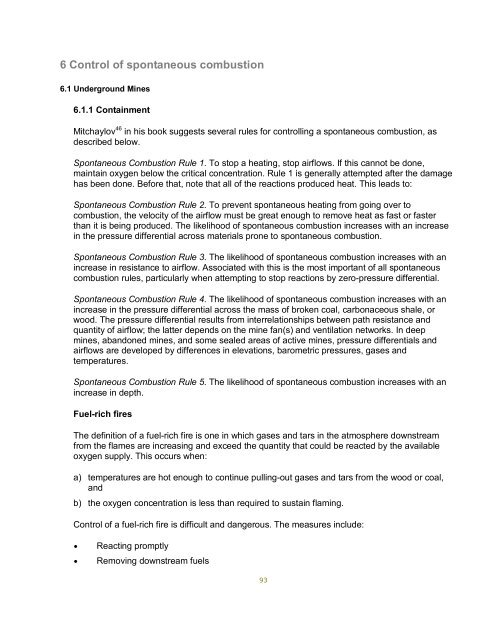prevention and control of spontaneous combustion - Mining and
prevention and control of spontaneous combustion - Mining and
prevention and control of spontaneous combustion - Mining and
Create successful ePaper yourself
Turn your PDF publications into a flip-book with our unique Google optimized e-Paper software.
6 Control <strong>of</strong> <strong>spontaneous</strong> <strong>combustion</strong><br />
6.1 Underground Mines<br />
6.1.1 Containment<br />
Mitchaylov 46 in his book suggests several rules for <strong>control</strong>ling a <strong>spontaneous</strong> <strong>combustion</strong>, as<br />
described below.<br />
Spontaneous Combustion Rule 1. To stop a heating, stop airflows. If this cannot be done,<br />
maintain oxygen below the critical concentration. Rule 1 is generally attempted after the damage<br />
has been done. Before that, note that all <strong>of</strong> the reactions produced heat. This leads to:<br />
Spontaneous Combustion Rule 2. To prevent <strong>spontaneous</strong> heating from going over to<br />
<strong>combustion</strong>, the velocity <strong>of</strong> the airflow must be great enough to remove heat as fast or faster<br />
than it is being produced. The likelihood <strong>of</strong> <strong>spontaneous</strong> <strong>combustion</strong> increases with an increase<br />
in the pressure differential across materials prone to <strong>spontaneous</strong> <strong>combustion</strong>.<br />
Spontaneous Combustion Rule 3. The likelihood <strong>of</strong> <strong>spontaneous</strong> <strong>combustion</strong> increases with an<br />
increase in resistance to airflow. Associated with this is the most important <strong>of</strong> all <strong>spontaneous</strong><br />
<strong>combustion</strong> rules, particularly when attempting to stop reactions by zero-pressure differential.<br />
Spontaneous Combustion Rule 4. The likelihood <strong>of</strong> <strong>spontaneous</strong> <strong>combustion</strong> increases with an<br />
increase in the pressure differential across the mass <strong>of</strong> broken coal, carbonaceous shale, or<br />
wood. The pressure differential results from interrelationships between path resistance <strong>and</strong><br />
quantity <strong>of</strong> airflow; the latter depends on the mine fan(s) <strong>and</strong> ventilation networks. In deep<br />
mines, ab<strong>and</strong>oned mines, <strong>and</strong> some sealed areas <strong>of</strong> active mines, pressure differentials <strong>and</strong><br />
airflows are developed by differences in elevations, barometric pressures, gases <strong>and</strong><br />
temperatures.<br />
Spontaneous Combustion Rule 5. The likelihood <strong>of</strong> <strong>spontaneous</strong> <strong>combustion</strong> increases with an<br />
increase in depth.<br />
Fuel-rich fires<br />
The definition <strong>of</strong> a fuel-rich fire is one in which gases <strong>and</strong> tars in the atmosphere downstream<br />
from the flames are increasing <strong>and</strong> exceed the quantity that could be reacted by the available<br />
oxygen supply. This occurs when:<br />
a) temperatures are hot enough to continue pulling-out gases <strong>and</strong> tars from the wood or coal,<br />
<strong>and</strong><br />
b) the oxygen concentration is less than required to sustain flaming.<br />
Control <strong>of</strong> a fuel-rich fire is difficult <strong>and</strong> dangerous. The measures include:<br />
• Reacting promptly<br />
• Removing downstream fuels<br />
93

















